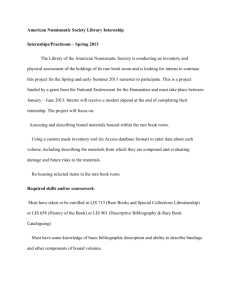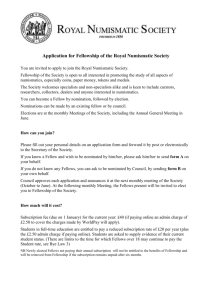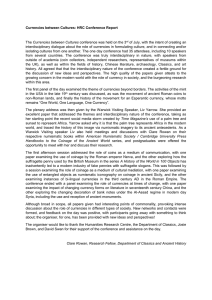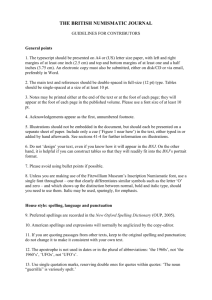the PDF (7 pgs)
advertisement
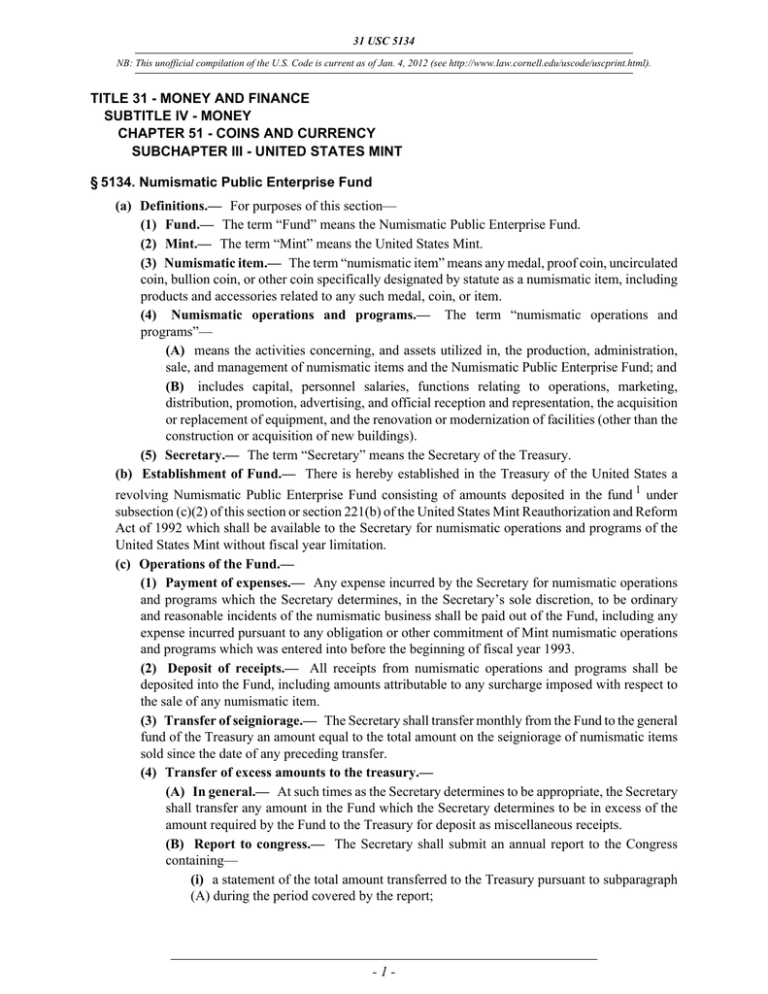
31 USC 5134 NB: This unofficial compilation of the U.S. Code is current as of Jan. 4, 2012 (see http://www.law.cornell.edu/uscode/uscprint.html). TITLE 31 - MONEY AND FINANCE SUBTITLE IV - MONEY CHAPTER 51 - COINS AND CURRENCY SUBCHAPTER III - UNITED STATES MINT § 5134. Numismatic Public Enterprise Fund (a) Definitions.— For purposes of this section— (1) Fund.— The term “Fund” means the Numismatic Public Enterprise Fund. (2) Mint.— The term “Mint” means the United States Mint. (3) Numismatic item.— The term “numismatic item” means any medal, proof coin, uncirculated coin, bullion coin, or other coin specifically designated by statute as a numismatic item, including products and accessories related to any such medal, coin, or item. (4) Numismatic operations and programs.— The term “numismatic operations and programs”— (A) means the activities concerning, and assets utilized in, the production, administration, sale, and management of numismatic items and the Numismatic Public Enterprise Fund; and (B) includes capital, personnel salaries, functions relating to operations, marketing, distribution, promotion, advertising, and official reception and representation, the acquisition or replacement of equipment, and the renovation or modernization of facilities (other than the construction or acquisition of new buildings). (5) Secretary.— The term “Secretary” means the Secretary of the Treasury. (b) Establishment of Fund.— There is hereby established in the Treasury of the United States a revolving Numismatic Public Enterprise Fund consisting of amounts deposited in the fund 1 under subsection (c)(2) of this section or section 221(b) of the United States Mint Reauthorization and Reform Act of 1992 which shall be available to the Secretary for numismatic operations and programs of the United States Mint without fiscal year limitation. (c) Operations of the Fund.— (1) Payment of expenses.— Any expense incurred by the Secretary for numismatic operations and programs which the Secretary determines, in the Secretary’s sole discretion, to be ordinary and reasonable incidents of the numismatic business shall be paid out of the Fund, including any expense incurred pursuant to any obligation or other commitment of Mint numismatic operations and programs which was entered into before the beginning of fiscal year 1993. (2) Deposit of receipts.— All receipts from numismatic operations and programs shall be deposited into the Fund, including amounts attributable to any surcharge imposed with respect to the sale of any numismatic item. (3) Transfer of seigniorage.— The Secretary shall transfer monthly from the Fund to the general fund of the Treasury an amount equal to the total amount on the seigniorage of numismatic items sold since the date of any preceding transfer. (4) Transfer of excess amounts to the treasury.— (A) In general.— At such times as the Secretary determines to be appropriate, the Secretary shall transfer any amount in the Fund which the Secretary determines to be in excess of the amount required by the Fund to the Treasury for deposit as miscellaneous receipts. (B) Report to congress.— The Secretary shall submit an annual report to the Congress containing— (i) a statement of the total amount transferred to the Treasury pursuant to subparagraph (A) during the period covered by the report; -1- 31 USC 5134 NB: This unofficial compilation of the U.S. Code is current as of Jan. 4, 2012 (see http://www.law.cornell.edu/uscode/uscprint.html). (ii) a statement of the amount by which the amount on deposit in the Fund at the end of the period covered by the report exceeds the estimated operating costs of the Fund for the 1-year period beginning at the end of such period; and (iii) an explanation of the specific purposes for which such excess amounts are being retained in the Fund. (d) Budget Treatment.— (1) In general.— The Secretary shall prepare budgets for the Fund, and estimates and statements of financial condition of the Fund in accordance with the requirements of section 9103 which shall be submitted to the President for inclusion in the budget submitted under section 1105. (2) Inclusion in annual report.— Statements of the financial condition of the Fund shall be included in the Secretary’s annual report on the operation of the Mint. (3) Treatment as wholly owned government corporation for certain purposes.— Section 9104 shall apply to the Fund to the same extent such section applies to wholly owned Government corporations. (e) Financial Statements, Audits, and Reports.— (1) Annual financial statement required.— By the end of each calendar year, the Secretary shall prepare an annual financial statement of the Fund for the fiscal year which ends during such calendar year. (2) Contents of financial statement.— Each statement prepared pursuant to paragraph (1) shall, at a minimum, contain— (A) the overall financial position (including assets and liabilities) of the Fund as of the end of the fiscal year; (B) the results of the numismatic operations and programs of the Fund during the fiscal year; (C) the cash flows or the changes in financial position of the Fund; (D) a reconciliation of the financial statement to the budget reports of the Fund; and (E) a supplemental schedule detailing— (i) the costs and expenses for the production, for the marketing, and for the distribution of each denomination of circulating coins produced by the Mint during the fiscal year and the per-unit cost of producing, of marketing, and of distributing each denomination of such coins; and (ii) the gross revenue derived from the sales of each such denomination of coins. (3) Annual audits.— (A) In general.— Each annual financial statement prepared under paragraph (1) shall be audited— (i) by— (I) an independent external auditor; or (II) the Inspector General of the Department of the Treasury, as designated by the Secretary; and (ii) in accordance with the generally accepted Government auditing standards issued by the Comptroller General of the United States. (B) Auditor’s report required.— The auditor designated to audit any financial statement of the Fund pursuant to subparagraph (A) shall submit a report— (i) to the Secretary by March 31 of the year beginning after the end of the fiscal year covered by such financial statement; and (ii) containing the auditor’s opinion on— (I) the financial statement of the Fund; -2- 31 USC 5134 NB: This unofficial compilation of the U.S. Code is current as of Jan. 4, 2012 (see http://www.law.cornell.edu/uscode/uscprint.html). (II) the internal accounting and administrative controls and accounting systems of the Fund; and (III) the Fund’s compliance with applicable laws and regulations. (4) Annual report on fund.— (A) Report required.— By April 30 of each year, the Secretary shall submit a report on the Fund for the most recently completed fiscal year to the President, the Congress, and the Director of the Office of Management and Budget. (B) Contents of annual report.— The annual report required under subparagraph (A) for any fiscal year shall include— (i) the financial statement prepared under paragraph (1) for such fiscal year; (ii) the audit report submitted to the Secretary pursuant to paragraph (3)(B) for such fiscal year; (iii) a description of activities carried out during such fiscal year; (iv) a summary of information relating to numismatic operations and programs contained in the reports on systems on internal accounting and administrative controls and accounting systems submitted to the President and the Congress under section 3512 (c); (v) a summary of the corrective actions taken with respect to material weaknesses relating to numismatic operations and programs identified in the reports prepared under section 3512 (c); (vi) any other information the Secretary considers appropriate to fully inform the Congress concerning the financial management of the Fund; and (vii) a statement of the total amount of excess funds transferred to the Treasury. (5) Marketing report.— (A) Report required for 10 years.— For each fiscal year beginning before fiscal year 2003, the Secretary shall submit an annual report on all marketing activities and expenses of the Fund to the Congress before the end of the 3-month period beginning at the end of such fiscal year. (B) Contents of report.— The report submitted pursuant to subparagraph (A) shall contain a detailed description of— (i) the sources of income including surcharges; and (ii) expenses incurred for manufacturing, materials, overhead, packaging, marketing, and shipping. (f) Conditions on Payment of Surcharges to Recipient Organizations.— (1) Payment of surcharges.— (A) In general.— Notwithstanding any other provision of law, no amount derived from the proceeds of any surcharge imposed on the sale of any numismatic item shall be paid from the fund 1 to any designated recipient organization unless— (i) all numismatic operation and program costs allocable to the program under which such numismatic item is produced and sold have been recovered; and (ii) the designated recipient organization submits an audited financial statement that demonstrates, to the satisfaction of the Secretary, that, with respect to all projects or purposes for which the proceeds of such surcharge may be used, the organization has raised funds from private sources for such projects and purposes in an amount that is equal to or greater than the total amount of the proceeds of such surcharge derived from the sale of such numismatic item. (B) Unpaid amounts.— If any amount derived from the proceeds of any surcharge imposed on the sale of any numismatic item that may otherwise be paid from the fund,1 under any provision of law relating to such numismatic item, to any designated recipient organization -3- 31 USC 5134 NB: This unofficial compilation of the U.S. Code is current as of Jan. 4, 2012 (see http://www.law.cornell.edu/uscode/uscprint.html). remains unpaid to such organization solely by reason of the matching fund requirement contained in subparagraph (A)(ii) after the end of the 2-year period beginning on the later of— (i) the last day any such numismatic item is issued by the Secretary; or (ii) the date of the enactment of the American 5-Cent Coin Design Continuity Act of 2003, such unpaid amount shall be deposited in the Treasury as miscellaneous receipts. (2) Annual audits.— (A) Annual audits of recipients required.— Each designated recipient organization that receives any payment from the fund 1 of any amount derived from the proceeds of any surcharge imposed on the sale of any numismatic item shall provide, as a condition for receiving any such amount, for an annual audit, in accordance with generally accepted government auditing standards by an independent public accountant selected by the organization, of all such payments to the organization beginning in the first fiscal year of the organization in which any such amount is received and continuing until all amounts received by such organization from the fund 1 with respect to such surcharges are fully expended or placed in trust. (B) Minimum requirements for annual audits.— At a minimum, each audit of a designated recipient organization pursuant to subparagraph (A) shall report— (i) the amount of payments received by the designated recipient organization from the fund 1 during the fiscal year of the organization for which the audit is conducted that are derived from the proceeds of any surcharge imposed on the sale of any numismatic item; (ii) the amount expended by the designated recipient organization from the proceeds of such surcharges during the fiscal year of the organization for which the audit is conducted; and (iii) whether all expenditures by the designated recipient organization during the fiscal year of the organization for which the audit is conducted from the proceeds of such surcharges were for authorized purposes. (C) Responsibility of organization to account for expenditures of surcharges.— Each designated recipient organization that receives any payment from the fund 1 of any amount derived from the proceeds of any surcharge imposed on the sale of any numismatic item shall take appropriate steps, as a condition for receiving any such payment, to ensure that the receipt of the payment and the expenditure of the proceeds of such surcharge by the organization in each fiscal year of the organization can be accounted for separately from all other revenues and expenditures of the organization. (D) Submission of audit report.— Not later than 90 days after the end of any fiscal year of a designated recipient organization for which an audit is required under subparagraph (A), the organization shall— (i) submit a copy of the report to the Secretary of the Treasury; and (ii) make a copy of the report available to the public. (E) Use of surcharges for audits.— Any designated recipient organization that receives any payment from the fund 1 of any amount derived from the proceeds of any surcharge imposed on the sale of any numismatic item may use the amount received to pay the cost of an audit required under subparagraph (A). (F) Waiver of paragraph.— The Secretary of the Treasury may waive the application of any subparagraph of this paragraph to any designated recipient organization for any fiscal year after taking into account the amount of surcharges that such organization received or expended during such year. -4- 31 USC 5134 NB: This unofficial compilation of the U.S. Code is current as of Jan. 4, 2012 (see http://www.law.cornell.edu/uscode/uscprint.html). (G) Nonapplicability to federal entities.— This paragraph shall not apply to any Federal agency or department or any independent establishment in the executive branch that receives any payment from the fund 1 of any amount derived from the proceeds of any surcharge imposed on the sale of any numismatic item. (H) Availability of books and records.— An organization that receives any payment from the fund 1 of any amount derived from the proceeds of any surcharge imposed on the sale of any numismatic item shall provide, as a condition for receiving any such payment, to the Inspector General of the Department of the Treasury or the Comptroller General of the United States, upon the request of such Inspector General or the Comptroller General, all books, records, and work papers belonging to or used by the organization, or by any independent public accountant who audited the organization in accordance with subparagraph (A), which may relate to the receipt or expenditure of any such amount by the organization. (3) Use of agents or attorneys to influence commemorative coin legislation.— No portion of any payment from the fund 1 to any designated recipient organization of any amount derived from the proceeds of any surcharge imposed on the sale of any numismatic item may be used, directly or indirectly, by the organization to compensate any agent or attorney for services rendered to support or influence in any way legislative action of the Congress relating to such numismatic item. (4) Designated recipient organization defined.— For purposes of this subsection, the term “designated recipient organization” means any organization designated, under any provision of law, as the recipient of any surcharge imposed on the sale of any numismatic item. (g) Quarterly Financial Reports.— (1) In general.— Not later than the 30th day of each month following each calendar quarter through and including the final period of sales with respect to any commemorative coin program authorized on or after the date of enactment of the Treasury, Postal Service, and General Government Appropriations Act, 1997, the Mint shall submit to the Congress a quarterly financial report in accordance with this subsection. (2) Requirements.— Each report submitted under paragraph (1) shall include, with respect to the calendar quarter at issue— (A) a detailed financial statement, prepared in accordance with generally accepted accounting principles, that includes financial information specific to that quarter, as well as cumulative financial information relating to the entire program; (B) a detailed accounting of— (i) all costs relating to marketing efforts; (ii) all funds projected for marketing use; (iii) all costs for employee travel relating to the promotion of commemorative coin programs; (iv) all numismatic items minted, sold, not sold, and rejected during the production process; and (v) the costs of melting down all rejected and unsold products; (C) adequate market-based research for all commemorative coin programs; and (D) a description of the efforts of the Mint in keeping the sale price of numismatic items as low as practicable. Footnotes 1 So in original. Probably should be capitalized. (Added Pub. L. 102–390, title II, § 221(a), Oct. 6, 1992, 106 Stat. 1624; amended Pub. L. 104–208, div. A, title I, § 101(f) [title V, § 529(b)(1), (2), (c)], Sept. 30, 1996, 110 Stat. 3009–314, 3009–349, -5- 31 USC 5134 NB: This unofficial compilation of the U.S. Code is current as of Jan. 4, 2012 (see http://www.law.cornell.edu/uscode/uscprint.html). 3009–350, 3009–352; Pub. L. 106–445, § 3, Nov. 6, 2000, 114 Stat. 1931; Pub. L. 108–15, title I, § 103(d)(2), title II, § 201(a), Apr. 23, 2003, 117 Stat. 619.) References in Text Section 221(b) of the United States Mint Reauthorization and Reform Act of 1992, referred to in subsec. (b), is section 221(b) of Pub. L. 102–390, which is set out below. The date of the enactment of the American 5-Cent Coin Design Continuity Act of 2003, referred to in subsec. (f)(1)(B)(ii), is the date of enactment of Pub. L. 108–15, which was approved Apr. 23, 2003. The date of enactment of the Treasury, Postal Service, and General Government Appropriations Act, 1997, referred to in subsec. (g)(1), is the date of enactment of section 101(f) of title I of div. A of Pub. L. 104–208, which was approved Sept. 30, 1996. Amendments 2003—Subsec. (c)(4), (5). Pub. L. 108–15, § 103(d)(2), redesignated par. (5) as (4) and struck out heading and text of former par. (4). Text read as follows: “For purposes of paragraph (1), any expense incurred by the Secretary in connection with the Citizens Commemorative Coin Advisory Committee established under section 5135 shall be treated as an expense incurred for numismatic operations and programs which is an ordinary and reasonable incident of the numismatic business.” Subsec. (f)(1). Pub. L. 108–15, § 201(a), amended heading and text of par. (1) generally. Prior to amendment, text read as follows: “Notwithstanding any other provision of law, no amount derived from the proceeds of any surcharge imposed on the sale of any numismatic item shall be paid from the fund to any designated recipient organization unless— “(A) all numismatic operation and program costs allocable to the program under which such numismatic item is produced and sold have been recovered; and “(B) the designated recipient organization submits an audited financial statement that demonstrates to the satisfaction of the Secretary of the Treasury that, with respect to all projects or purposes for which the proceeds of such surcharge may be used, the organization has raised funds from private sources for such projects and purposes in an amount that is equal to or greater than the maximum amount the organization may receive from the proceeds of such surcharge.” 2000—Subsec. (e)(2). Pub. L. 106–445, § 3(1), substituted “contain” for “reflect” in introductory provisions. Subsec. (e)(2)(E). Pub. L. 106–445, § 3(2)–(4), added subpar. (E). 1996—Subsec. (c)(2). Pub. L. 104–208, § 101(f) [title V, § 529(b)(1)], inserted “, including amounts attributable to any surcharge imposed with respect to the sale of any numismatic item” before period at end. Subsec. (f). Pub. L. 104–208, § 101(f) [title V, § 529(b)(2)], added subsec. (f). Subsec. (g). Pub. L. 104–208, § 101(f) [title V, § 529(c)], added subsec. (g). Effective Date of 2003 Amendment Pub. L. 108–15, title II, § 201(b), Apr. 23, 2003, 117 Stat. 620, provided that: “The amendment made by subsection (a) [amending this section] shall apply as of the date of the enactment of Public Law 104–208 [Sept. 30, 1996].” Effective Date of 1996 Amendment Section 101 (f) [title V, § 529(b)(3)] of Pub. L. 104–208 provided that: “The amendments made by this section [probably should be this subsection, amending this section] shall apply with respect to the proceeds of any surcharge imposed on the sale of any numismatic item that are deposited in the Numismatic Public Enterprise Fund after the date of the enactment of this Act [Sept. 30, 1996].” Effective Date Section applicable with respect to fiscal years beginning after fiscal year 1992, see section 221(e) of Pub. L. 102–390, set out as an Effective Date of 1992 Amendment note under section 5132 of this title. Termination of Numismatic Public Enterprise Fund All assets and liabilities of Numismatic Public Enterprise Fund transferred to United States Mint Public Enterprise Fund and Numismatic Public Enterprise Fund to cease to exist as separate fund as its activities and functions are subsumed under and subject to United States Mint Public Enterprise Fund, see section 5136 of this title. -6- 31 USC 5134 NB: This unofficial compilation of the U.S. Code is current as of Jan. 4, 2012 (see http://www.law.cornell.edu/uscode/uscprint.html). Initial Funding of Fund From Existing Numismatic Operations Section 221(b) of Pub. L. 102–390 provided that: “(1) In general.—As soon as practicable after the end of fiscal year 1992, the Secretary of the Treasury shall transfer to the Fund— “(A) from the Mint’s numismatic profits for such fiscal year, an amount which the Secretary determines to be necessary— “(i) to meet existing numismatic liabilities and obligations; and “(ii) to provide working capital for Mint numismatic operations and programs; and “(B) all numismatic receivables, and the numismatic operations and programs (including liabilities and other obligations) of the United States Mint, and the land and buildings of the San Francisco Mint, the Old San Francisco Mint, and the West Point Mint, capitalized at current book value as carried in the Mint combined statement of financial condition. “(2) Excess amounts to be deposited in the general fund.—That portion of the total amount of numismatic profits for fiscal year 1992 which remains after the transfer to the Fund pursuant to paragraph (1)(A) is made shall be deposited by the Secretary in the general fund of the Treasury as soon as practicable after the end of the fiscal year. “(3) Definitions.—For purposes of paragraphs (1) and (2)— “(A) Numismatic profit.—The term ‘numismatic profit’ means the amount which is equal to the proceeds (including seigniorage) from the sale of numismatic items minus the costs of numismatic operations and programs. “(B) Numismatic receivable.—The term ‘numismatic receivable’ means any account receivable from numismatic operations and programs, including chargebacks, returned checks, amounts due from special order sales, and amounts due from consignment sales. “(C) Other terms.—The terms ‘Fund’ and ‘numismatic item’ have the meaning given to such terms in the amendment made by subsection (a) [enacting this section].” -7-
